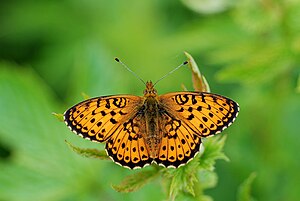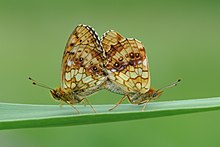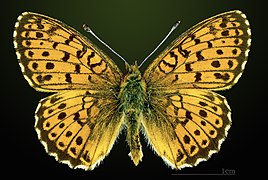Meadowsweet mother-of-pearl
| Meadowsweet mother-of-pearl | ||||||||||||
|---|---|---|---|---|---|---|---|---|---|---|---|---|

Meadowsweet mother-of-pearl butterfly ( Brenthis ino ) |
||||||||||||
| Systematics | ||||||||||||
|
||||||||||||
| Scientific name | ||||||||||||
| Brenthis ino | ||||||||||||
| ( Rottemburg , 1775) |
The meadowsweet mother-of-pearl butterfly or violet silver butterfly ( Brenthis ino ) is a butterfly (day butterfly ) from the noble butterfly family (Nymphalidae). The specific epithet is derived from Ino , the daughter of Kadmos from Greek mythology .
features
The moths reach a wingspan of 32 to 40 millimeters. The wing tops are patterned yellow-orange and black. The outer edge of both pairs of wings is black with a fine dashed white border on the edges. Inward, two rows of black dots are arranged parallel to the outer edge. The one further inside has slightly larger spots that are missing in some areas. The underside of the wing is light yellow and a little brown in color. On the hind wings there is a brown transverse band shortly after the middle, in which there is a strong purple-white stripe. There are also several black dots with white inclusions. From the middle to the base of the wings, light yellow fields are outlined with brown lines.
The caterpillars are about 25 millimeters long. They are white, gray and brown striped lengthways. They have yellow thorns with white tips.
Occurrence
They are widespread in Central Europe , but have become rare in many places due to the decline in their habitats. They live on wet meadows and on moist forest edges where their herbivorous plants grow, but rarely occur on dry grassland and other open and dry areas.
Flight and caterpillar times
The meadowsweet mother-of-pearl butterfly flies in one generation from mid-May to mid-August. The caterpillars can be found from late May to mid-June.
Way of life
The animals fly in one generation per year and usually eat on purple flowers such as knapweed ( Centaurea spec. ) And thistles ( Carduus spec. ).
Food of the caterpillars
The caterpillars feed on the leaves of the real meadowsweet ( Filipendula ulmaria ) and occasionally also on those of the great meadow button ( Sanguisorba officialis ). But they probably also eat other rose plants . Ebert also names the flesh-colored orchid ( Dactylorhiza incarnata ) as a host plant .
development
The females lay their eggs individually on the underside of the leaves of the forage plants. But they do this by sitting on the top and sticking the eggs through a hole at the bottom. The fall dolls are light brown and have bright, metallic, shiny spots on their backs.
swell
Individual evidence
- ^ Arnold Spuler: The butterflies of Europe . tape 1 . E. Schweitzerbartsche Verlagbuchhandlung, Stuttgart 1908, p. 29 .
- ↑ Günter Ebert (Ed.): The butterflies of Baden-Württemberg Volume 1, Tagfalter I (Ritterfalter (Papilionidae), Weißlinge (Pieridae), Edelfalter (Nymphalidae)), Ulmer Verlag Stuttgart 1993, ISBN 3-800-13451-9
literature
- Heiko Bellmann : The new Kosmos butterfly guide. Butterflies, caterpillars and forage plants. Franckh-Kosmos, Stuttgart 2003, ISBN 3-440-09330-1 .
- Tom Tolman, Richard Lewington: The butterflies of Europe and Northwest Africa , Franckh-Kosmos Verlags-GmbH & Co, Stuttgart 1998, ISBN 3-440-07573-7
- Hans-Josef Weidemann: Butterfly: observe, determine , Naturbuch-Verlag Augsburg 1995, ISBN 3-894-40115-X
Web links
- Lepiforum e. V. Taxonomy and Photos
- Brenthis ino at Fauna Europaea
- www.schmetterling-raupe.de
- Heiner Ziegler: Butterflies of Switzerland
- Moths and Butterflies of Europe and North Africa (English)


